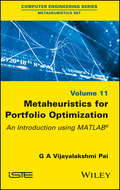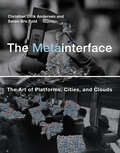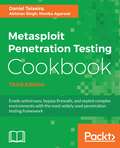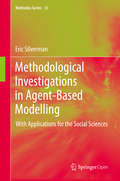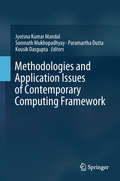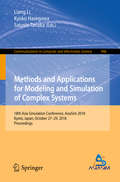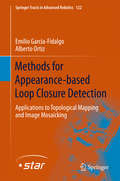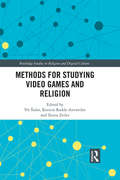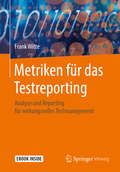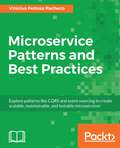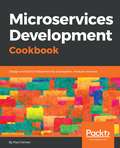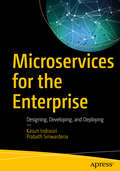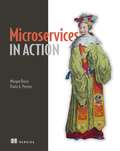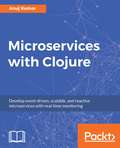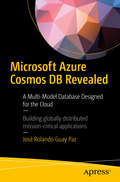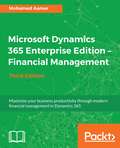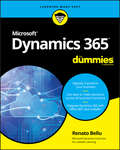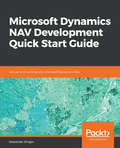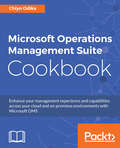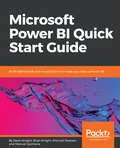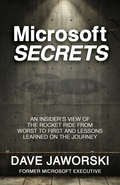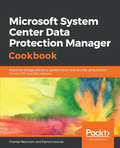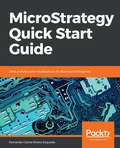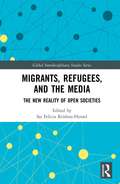- Table View
- List View
Metaheuristics for Portfolio Optimization: An Introduction using MATLAB
by G. A. Vijayalakshmi PaiThe book is a monograph in the cross disciplinary area of Computational Intelligence in Finance and elucidates a collection of practical and strategic Portfolio Optimization models in Finance, that employ Metaheuristics for their effective solutions and demonstrates the results using MATLAB implementations, over live portfolios invested across global stock universes. The book has been structured in such a way that, even novices in finance or metaheuristics should be able to comprehend and work on the hybrid models discussed in the book.
The Metainterface: The Art of Platforms, Cities, and Clouds (The\mit Press Ser.)
by Christian Ulrik Andersen Soren Bro PoldHow the interface has moved from the PC into cultural platforms, as seen in a series of works of net art, software art and electronic literature.The computer interface is both omnipresent and invisible, at once embedded in everyday objects and characterized by hidden exchanges of information between objects. The interface has moved from office into culture, with devices, apps, the cloud, and data streams as new cultural platforms. In The Metainterface, Christian Ulrik Andersen and Søren Bro Pold examine the relationships between art and interfaces, tracing the interface's disruption of everyday cultural practices. They present a new interface paradigm of cloud services, smartphones, and data capture, and examine how particular art forms—including net art, software art, and electronic literature—seek to reflect and explore this paradigm.Andersen and Pold argue that despite attempts to make the interface disappear into smooth access and smart interaction, it gradually resurfaces; there is a metainterface to the displaced interface. Art can help us see this; the interface can be an important outlet for aesthetic critique. Andersen and Pold describe the “semantic capitalism” of a metainterface industry that captures user behavior; the metainterface industry's disruption of everyday urban life, changing how the city is read, inhabited, and organized; the ways that the material displacement of the cloud affects the experience of the interface; and the potential of designing with an awareness of the language and grammar of interfaces.
Metasploit Penetration Testing Cookbook: Evade antiviruses, bypass firewalls, and exploit complex environments with the most widely used penetration testing framework, 3rd Edition
by Daniel Teixeira Abhinav Singh Monika Agarwal Nipun JaswalOver 100 recipes for penetration testing using Metasploit and virtual machines Key Features Special focus on the latest operating systems, exploits, and penetration testing techniques Learn new anti-virus evasion techniques and use Metasploit to evade countermeasures Automate post exploitation with AutoRunScript Exploit Android devices, record audio and video, send and read SMS, read call logs, and much more Build and analyze Metasploit modules in Ruby Integrate Metasploit with other penetration testing tools Book Description Metasploit is the world's leading penetration testing tool and helps security and IT professionals find, exploit, and validate vulnerabilities. Metasploit allows penetration testing automation, password auditing, web application scanning, social engineering, post exploitation, evidence collection, and reporting. Metasploit's integration with InsightVM (or Nexpose), Nessus, OpenVas, and other vulnerability scanners provides a validation solution that simplifies vulnerability prioritization and remediation reporting. Teams can collaborate in Metasploit and present their findings in consolidated reports. In this book, you will go through great recipes that will allow you to start using Metasploit effectively. With an ever increasing level of complexity, and covering everything from the fundamentals to more advanced features in Metasploit, this book is not just for beginners but also for professionals keen to master this awesome tool. You will begin by building your lab environment, setting up Metasploit, and learning how to perform intelligence gathering, threat modeling, vulnerability analysis, exploitation, and post exploitation—all inside Metasploit. You will learn how to create and customize payloads to evade anti-virus software and bypass an organization's defenses, exploit server vulnerabilities, attack client systems, compromise mobile phones, automate post exploitation, install backdoors, run keyloggers, highjack webcams, port public exploits to the framework, create your own modules, and much more. What you will learn Set up a complete penetration testing environment using Metasploit and virtual machines Master the world's leading penetration testing tool and use it in professional penetration testing Make the most of Metasploit with PostgreSQL, importing scan results, using workspaces, hosts, loot, notes, services, vulnerabilities, and exploit results Use Metasploit with the Penetration Testing Execution Standard methodology Use MSFvenom efficiently to generate payloads and backdoor files, and create shellcode Leverage Metasploit's advanced options, upgrade sessions, use proxies, use Meterpreter sleep control, and change timeouts to be stealthy Who this book is for If you are a Security professional or pentester and want to get into vulnerability exploitation and make the most of the Metasploit framework, then this book is for you. Some prior understanding of penetration testing and Metasploit is required.
Methodological Investigations in Agent-Based Modelling: With Applications For The Social Sciences (Methodos Ser. #13)
by Eric Silverman Daniel Courgeau Robert Franck Jakub Bijak Jason Hilton Jason Noble John BrydenThis open access book examines the methodological complications of using complexity science concepts within the social science domain. The opening chapters take the reader on a tour through the development of simulation methodologies in the fields of artificial life and population biology, then demonstrates the growing popularity and relevance of these methods in the social sciences. Following an in-depth analysis of the potential impact of these methods on social science and social theory, the text provides substantive examples of the application of agent-based models in the field of demography. This work offers a unique combination of applied simulation work and substantive, in-depth philosophical analysis, and as such has potential appeal for specialist social scientists, complex systems scientists, and philosophers of science interested in the methodology of simulation and the practice of interdisciplinary computing research.
Methodologies and Application Issues of Contemporary Computing Framework
by Jyotsna Kumar Mandal Somnath Mukhopadhyay Paramartha Dutta Kousik DasguptaThis book brings together the diversified areas of contemporary computing frameworks in the field of Computer Science, Engineering and Electronic Science. It focuses on various techniques and applications pertaining to cloud overhead, cloud infrastructure, high speed VLSI circuits, virtual machines, wireless and sensor networks, clustering and extraction of information from images and analysis of e-mail texts. The state-of-the-art methodologies and techniques are addressed in chapters presenting various proposals for enhanced outcomes and performances. The techniques discussed are useful for young researchers, budding engineers and industry professionals for applications in their respective fields.
Methods and Applications for Modeling and Simulation of Complex Systems: 18th Asia Simulation Conference, AsiaSim 2018, Kyoto, Japan, October 27–29, 2018, Proceedings (Communications in Computer and Information Science #946)
by Liang Li Kyoko Hasegawa Satoshi TanakaThis volume constitutes the proceedings of the 18th Asia Simulation Conference, AsiaSim 2018, held in Kyoto, Japan, in August 2018.The 45 revised full papers presented in this volume were carefully reviewed and selected from 90 submissions. The papers are organized in topical sections on modeling and simulation technology; soft computing and machine learning; high performance computing and cloud computing; simulation technology for industry; simulation technology for intelligent society; simulation of instrumentation and control application; computational mathematics and computational science; flow simulation; visualization and computer vision to support simulation.
Methods for Appearance-based Loop Closure Detection: Applications To Topological Mapping And Image Mosaicking (Springer Tracts In Advanced Robotics #122)
by Emilio Garcia-Fidalgo Alberto OrtizMapping and localization are two essential tasks in autonomous mobile robotics. Due to the unavoidable noise that sensors present, mapping algorithms usually rely on loop closure detection techniques, which entail the correct identification of previously seen places to reduce the uncertainty of the resulting maps. This book deals with the problem of generating topological maps of the environment using efficient appearance-based loop closure detection techniques. Since the quality of a visual loop closure detection algorithm is related to the image description method and its ability to index previously seen images, several methods for loop closure detection adopting different approaches are developed and assessed. Then, these methods are used in three novel topological mapping algorithms. The results obtained indicate that the solutions proposed attain a better performance than several state-of-the-art approaches. To conclude, given that loop closure detection is also a key component in other research areas, a multi-threaded image mosaicing algorithm is proposed. This approach makes use of one of the loop closure detection techniques previously introduced in order to find overlapping pairs between images and finally obtain seamless mosaics of different environments in a reasonable amount of time.
Methods for Studying Video Games and Religion (Routledge Studies in Religion and Digital Culture)
by Vít Šisler Kerstin Radde-Antweiler Xenia ZeilerGame studies has been an understudied area within the emerging field of digital media and religion. Video games can reflect, reject, or reconfigure traditionally held religious ideas and often serve as sources for the production of religious practices and ideas. This collection of essays presents a broad range of influential methodological approaches that illuminate how and why video games shape the construction of religious beliefs and practices, and also situates such research within the wider discourse on how digital media intersect with the religious worlds of the 21st century. Each chapter discusses a particular method and its theoretical background, summarizes existing research, and provides a practical case study that demonstrates how the method specifically contributes to the wider study of video games and religion. Featuring contributions from leading and emerging scholars of religion and digital gaming, this book will be an invaluable resource for scholars in the areas of digital culture, new media, religious studies, and game studies across a wide range of disciplines.
Metriken für das Testreporting
by Frank WitteZu jeder Softwareentwicklung gehört es dazu, das Management regelmäßig über Fortschritte und etwaige Probleme des Projekts zu informieren. Dieses Buch stellt verschiedene Testgrößen und Metriken vor, mit denen sich Fortschritte im Rahmen eines Softwaretests plastisch darstellen lassen und Handlungsbedarf leicht zu identifizieren ist. Detailreich werden dazu die für ein erfolgreiches Reporting wesentlichen Kenngrößen und Indexwerte erklärt. Ausgehend von der historischen Entwicklung des Testreportings erläutert der Autor den grundsätzlichen Nutzen der Metriken und gibt einen Überblick darüber, welche verschiedenen Arten von Metriken es gibt und wie sie im Softwaretest sinnvoll eingesetzt werden können. Er zeigt, wie sich, angefangen bei der Testspezifikation über die Testdurchführung bis hin zur Entwicklung der Testabdeckung, eine bestimmte Metrik individuell auf eine zu testende Software abstimmen lässt und wie man dadurch eine Automatisierung der Tests erreichen kann. Daneben stellt er Vorzüge und Nachteile jener Testmetriken auf, die auf Fehlern basieren, also die die Fehleranzahl, die Fehlerdichte und die Entwicklung der Fehler im Zeitverlauf messen. Mit dieser ausführlichen Auseinandersetzung mit dem Testreporting liefert der Autor eine optimale Bewertungsgrundlage, mit der sich nicht nur einschätzen lässt, welche Testmetrik man für welchen Einsatzzweck bzw. welche individuellen Projektsituation verwenden sollte, sondern auch, worin besondere Probleme einer einzelnen Metrik für das Testreporting bestehen können und wie man diese Probleme am besten löst. Damit richtet sich dieser praktische Leitfaden vor allem an Mitarbeiter in IT-Projekten, wie Projektleiter, Softwaretester und Entwickler, aber auch Unternehmens- und Technologieberater sowie Dozenten an Hochschulen und Universitäten finden hier einen spannenden Einblick in verschiedene Methoden des Softwaretestings.
Microservice Patterns and Best Practices: Explore patterns like CQRS and event sourcing to create scalable, maintainable, and testable microservices
by Vinicius Feitosa PachecoExplore the concepts and tools you need to discover the world of microservices with various design patterns Key Features Get to grips with the microservice architecture and build enterprise-ready microservice applications Learn design patterns and the best practices while building a microservice application Obtain hands-on techniques and tools to create high-performing microservices resilient to possible fails Book Description Microservices are a hot trend in the development world right now. Many enterprises have adopted this approach to achieve agility and the continuous delivery of applications to gain a competitive advantage. This book will take you through different design patterns at different stages of the microservice application development along with their best practices. Microservice Patterns and Best Practices starts with the learning of microservices key concepts and showing how to make the right choices while designing microservices. You will then move onto internal microservices application patterns, such as caching strategy, asynchronism, CQRS and event sourcing, circuit breaker, and bulkheads. As you progress, you'll learn the design patterns of microservices. The book will guide you on where to use the perfect design pattern at the application development stage and how to break monolithic application into microservices. You will also be taken through the best practices and patterns involved while testing, securing, and deploying your microservice application. At the end of the book, you will easily be able to create interoperable microservices, which are testable and prepared for optimum performance. What you will learn How to break monolithic application into microservices Implement caching strategies, CQRS and event sourcing, and circuit breaker patterns Incorporate different microservice design patterns, such as shared data, aggregator, proxy, and chained Utilize consolidate testing patterns such as integration, signature, and monkey tests Secure microservices with JWT, API gateway, and single sign on Deploy microservices with continuous integration or delivery, Blue-Green deployment Who this book is for This book is for architects and senior developers who would like implement microservice design patterns in their enterprise application development. The book assumes some prior programming knowledge.
Microservice Patterns and Best Practices: Explore Patterns Like Cqrs And Event Sourcing To Create Scalable, Maintainable, And Testable Microservices
by Vinicius Feitosa PachecoMicroservices are a hot trend in the development world right now. Many enterprises have adopted this approach to achieve agility and the continuous delivery of applications to gain a competitive advantage. This book will take you through the different design patterns at different stages of the microservice application development process, along with best practices.
Microservices Development Cookbook: Design and build independently deployable, modular services
by Paul OsmanQuickly learn and employ practical methods for developing microservicesKey FeaturesGet to grips with microservice architecture to build enterprise-ready applicationsAdopt the best practices to find solutions to specific problemsMonitor and manage your services in productionBook DescriptionMicroservices have become a popular way to build distributed systems that power modern web and mobile apps. Deploying your application as a suite of independently deployable, modular, and scalable services has many benefits. In this book, you'll learn to employ microservices in order to make your application more fault-tolerant and easier to scale and change.Using an example-driven approach, Microservice Development Cookbook introduces you to the microservice architectural style. You'll learn how to transition from a traditional monolithic application to a suite of small services that interact to provide smooth functionality to your client applications. You'll also learn about the patterns used to organize services, so you can optimize request handling and processing and see how to handle service-to-service interactions. You'll then move on to understanding how to secure microservices and add monitoring in order to debug problems. This book also covers fault-tolerance and reliability patterns that help you use microservices to isolate failures in your applications.By the end of the book, you’ll be able to work with a team to break a large, monolithic codebase into independently deployable and scalable microservices. You'll also study how to efficiently and effortlessly manage a microservice-based architecture.What you will learnLearn how to design microservice-based systemsCreate services that fail without impacting usersMonitor your services to perform debugging and create observable systemsManage the security of your servicesCreate fast and reliable deployment pipelinesManage multiple environments for your servicesSimplify the local development of microservice-based systemsWho this book is forMicroservice Development Cookbook is for developers who would like to build effective and scalable microservices. Basic knowledge of the microservices architecture is assumed.
Microservices for the Enterprise: Designing, Developing, and Deploying
by Kasun Indrasiri Prabath SiriwardenaUnderstand the key challenges and solutions around building microservices in the enterprise application environment. This book provides a comprehensive understanding of microservices architectural principles and how to use microservices in real-world scenarios.Architectural challenges using microservices with service integration and API management are presented and you learn how to eliminate the use of centralized integration products such as the enterprise service bus (ESB) through the use of composite/integration microservices. Concepts in the book are supported with use cases, and emphasis is put on the reality that most of you are implementing in a “brownfield” environment in which you must implement microservices alongside legacy applications with minimal disruption to your business. Microservices for the Enterprise covers state-of-the-art techniques around microservices messaging, service development and description, service discovery, governance, and data management technologies and guides you through the microservices design process. Also included is the importance of organizing services as core versus atomic, composite versus integration, and API versus edge, and how such organization helps to eliminate the use of a central ESB and expose services through an API gateway.What You'll LearnDesign and develop microservices architectures with confidencePut into practice the most modern techniques around messaging technologies Apply the Service Mesh pattern to overcome inter-service communication challengesApply battle-tested microservices security patterns to address real-world scenariosHandle API management, decentralized data management, and observabilityWho This Book Is ForDevelopers and DevOps engineers responsible for implementing applications around a microservices architecture, and architects and analysts who are designing such systems
Microservices in Action
by Morgan Bruce Paulo A PereiraSummaryMicroservices in Action is a practical book about building and deploying microservice-based applications. Written for developers and architects with a solid grasp of service-oriented development, it tackles the challenge of putting microservices into production.Purchase of the print book includes a free eBook in PDF, Kindle, and ePub formats from Manning Publications.About the TechnologyInvest your time in designing great applications, improving infrastructure, and making the most out of your dev teams. Microservices are easier to write, scale, and maintain than traditional enterprise applications because they're built as a system of independent components. Master a few important new patterns and processes, and you'll be ready to develop, deploy, and run production-quality microservices.About the BookMicroservices in Action teaches you how to write and maintain microservice-based applications. Created with day-to-day development in mind, this informative guide immerses you in real-world use cases from design to deployment. You'll discover how microservices enable an efficient continuous delivery pipeline, and explore examples using Kubernetes, Docker, and Google Container Engine. What's insideAn overview of microservice architectureBuilding a delivery pipelineBest practices for designing multi-service transactions and queriesDeploying with containersMonitoring your microservicesAbout the ReaderWritten for intermediate developers familiar with enterprise architecture and cloud platforms like AWS and GCP.About the AuthorMorgan Bruce and Paulo A. Pereira are experienced engineering leaders. They work daily with microservices in a production environment, using the techniques detailed in this book.Table of ContentsPART 1 - The lay of the landDesigning and running microservices Microservices at SimpleBankPART 2 - DesignArchitecture of a microservice application Designing new features Transactions and queries in microservices Designing reliable services Building a reusable microservice framework PART 3 - DeploymentDeploying microservices Deployment with containers and schedulers Building a delivery pipeline for microservices PART 4 - Observability and ownershipBuilding a monitoring system Using logs and traces to understand behavior Building microservice teams
Microservices with Clojure: Develop event-driven, scalable, and reactive microservices with real-time monitoring
by Anuj Kumar Michael VitzThe common patterns and practices of the microservice architecture and their application using the Clojure programming language. Key Features Relevance of the microservice architecture and benefits of Clojure's functional and simple features to implement it. Learn best practices and common principles to avoid common pitfalls while developing microservices. Learn how to use Pedestal to build your next microservices, secure them using JWT, and monitor them using the ELK stack Book Description The microservice architecture is sweeping the world as the de facto pattern with which to design and build scalable, easy-tomaintain web applications. This book will teach you common patterns and practices, and will show you how to apply these using the Clojure programming language. This book will teach you the fundamental concepts of architectural design and RESTful communication, and show you patterns that provide manageable code that is supportable in development and at scale in production. We will provide you with examples of how to put these concepts and patterns into practice with Clojure. This book will explain and illustrate, with practical examples, how teams of all sizes can start solving problems with microservices. You will learn the importance of writing code that is asynchronous and non-blocking and how Pedestal helps us do this. Later, the book explains how to build Reactive microservices in Clojure that adhere to the principles underlying the Reactive Manifesto. We finish off by showing you various ways to monitor, test, and secure your microservices. By the end, you will be fully capable of setting up, modifying, and deploying a microservice with Clojure and Pedestal. What you will learn Explore the pros and cons of monolithic and microservice architectures Use Clojure to effectively build a reallife application using Microservices Gain practical knowledge of the Clojure Pedestal framework and how to use it to build Microservices Explore various persistence patterns and learn how to use Apache Kafka to build event-driven microservice architectures Secure your Microservices using JWT Monitor Microservices at scale using the ELK stack Deploy Microservices at scale using container orchestration platforms such as KubernetesWho this book is for You should have a working knowledge of programming in Clojure. However, no knowledge of RESTful architecture, microservices, or web services is expected. If you are looking to apply techniques to your own projects, taking your first steps into microservice architecture, this book is for you.
Microsoft Azure Cosmos DB Revealed: A Multi-Model Database Designed for the Cloud
by José Rolando Guay PazLearn the main features of Azure Cosmos DB and how to use Microsoft’s multi-model database service as a data store for mission-critical applications. The clear examples help in writing your own applications to take advantage of Cosmos DB’s multi-model, globally distributed, elastic database. Simple step-by-step instructions show how to resolve common and uncommon scenarios involving Azure Cosmos DB, and scenarios such as delivering extremely low response times (in the order of milliseconds), and scaling rapidly and globally.Microsoft Azure Cosmos DB Revealed demonstrates a multitude of possible implementations to get you started. This book guides you toward best practices to get the most out of Microsoft’s Cosmos DB service. Later chapters in the book cover advanced implementation features, helping you master important elements such as securing the database, querying, and using various APIs. What You'll LearnSet up a development environment to work with Azure Cosmos DBConfigure Azure Cosmos DB in a production environment with multi-region distributionQuery using all APIs, including SQL, JavaScript, MongoDB, and GraphWork with the Azure Cosmos DB.NET SDK in an application you builtAccess Cosmos DB from web applications created in .NETWho This Book Is ForDevelopers who build applications to be hosted in Microsoft Azure, whether they use PaaS or IaaS. No previous knowledge of Azure Cosmos DB is assumed, but readers must be familiar with developing applications in Microsoft Visual Studio.
Microsoft Dynamics 365 Enterprise Edition – Financial Management: Maximize your business productivity through modern financial management in Dynamics 365, 3rd Edition
by Mohamed Aamer Ala El DinBoost your accounting and financial skills with Microsoft Dynamics 365Key FeaturesMake real-time data-driven decisions for your enterprise with Microsoft Dynamics 365 Enterprise editionConfigure and set up the Microsoft Dynamics 365 financial module via highly useful tips and tricksAdminister customer relations and plan enterprise resources with this systematic guideBook DescriptionMicrosoft Dynamics 365 for finance and operations is a rapidly growing application and is widely used in enterprise organizations. Because of its ability to maximize business productivity, it is a fast-growing business application package in the ERP market.We will start by looking into ERP concepts, implementation needs, and interface design, giving you basic knowledge of financial management aspects and explaining key concepts along the way. To begin with, you'll be taken through the general ledger and financial dimension functions. You'll later learn about the sales tax mechanism and multi-currency in Microsoft Dynamics 365. We tackle each topic with focused examples and explanations on topics such as payable/receivable accounts, forecasting, cash and bank management, budgeting planning/control, and fixed assets. Finally, we walk you through intercompany, consolidation, costing basics, and financial reporting.By the end of this book, your finance team will have a much richer understanding of Microsoft Dynamics 365 for finance and operations and its powerful capabilities.What you will learnExamine the business logic behind the financial functionalities of Microsoft Dynamics 365 FFOSet up and configure the core modules of financial managementGrasp the key control points of financial managementExplore intercompany and consolidation in Microsoft Dynamics 365 FFOUnderstand multi-currency sales, tax mechanisms, and budgeting capabilities in Microsoft Dynamics 365 FFOGet to grips with month/year-end period close functionalityUnderstand the account payable and receivable moduleUse Microsoft Dynamics 365 to create financial reportsWho this book is forThis book is for application consultants, solution architects, controllers, CFOs, pre-sales and other professionals who are involved in a Microsoft Dynamics 365 for finance and operation implementation. Basic knowledge of financial terms, concepts, and terminologies is required.
Microsoft Dynamics 365 For Dummies
by Renato BelluAccelerate your digital transformation and break down silos with Microsoft Dynamics 365 It’s no secret that running a business involves several complex parts like managing staff, financials, marketing, and operations—just to name a few. That’s where Microsoft Dynamics 365, the most profitable business management tool, comes in. In Microsoft Dynamics 365 For Dummies, you’ll learn the aspects of the program and each of its applications from Customer Service to Financial Management. With expert author Renato Bellu’s clear instructions and helpful tips, you’ll be managing to your fullest advantage before you know it. Let’s get started! Digitally transform your business by connecting CRM and ERP Use data to make decisions across all business functions Integrate Dynamics 365 with Office 365 and LinkedIn Manage financials and operations Are you running a dynamic business? This book shows you how!
Microsoft Dynamics NAV Development Quick Start Guide: Get up and running with Microsoft Dynamics NAV
by Alexander DroginLearn development skills and improve productivity when programming in Microsoft Dynamics NAV 2018 - the popular Enterprise Resourse Planning management system used across a variety of industries for business process management Key Features Solve common business problems with the valuable features and flexibility of Dynamics NAV Understand the structure of NAV database - how documents and business entities are mapped to DB tables Design user interface and bind the presentation layer with the data storage Book Description Microsoft Dynamics NAV is an enterprise resource planning (ERP) software suite for organizations. The system offers specialized functionality for manufacturing, distribution, government, retail, and other industries. This book gets you started with its integrated development environment for solving problems by customizing business processes. This book introduces the NAV development environment – C/SIDE. It gives an overview of the internal system language and the most essential development tools. The book will enable the reader to customize and extend NAV functionality with C/AL code, design a user interface through pages, create role centers, and build advanced reports in Microsoft Visual Studio. By the end of the book, you will have learned how to extend the NAV data model, how to write and debug custom code, and how to exchange data with external applications. What you will learn Manage NAV Server configuration with Microsoft Management Console Manage NAV installation with the NAV Administration Shell Create integration events and extend functionality via the NAV event model Run XML Ports from C/AL code Design reports and write client code in RDLC expressions Who this book is for This book is for experienced NAV users who have an understanding of basic programming concepts. Familiarity with NAV development environment or its internal development language-C/AL is not expected.
Microsoft Operations Management Suite Cookbook: Enhance your management experience and capabilities across your cloud and on-premises environments with Microsoft OMS
by Chiyo OdikaManage on-premises and cloud IT assets from one consoleKey FeaturesEmpower yourself with practical recipes to collect and analyze operational insights on Windows and Linux servers in your on premises datacenters and in any public cloud environments such as Azure and AWS.Build capabilities through practical tasks and techniques to collect and analyze machine dataAddress business challenges and discover means to accommodate workloads and instances in a low cost mannerBook DescriptionMicrosoft Operations Management Suite Cookbook begins with an overview of how to hit the ground running with OMS insights and analytics. Next, you will learn to search and analyze data to retrieve actionable insights, review alert generation from the analyzed data, and use basic and advanced Log search queries in Azure Log Analytics. Following this, you will explore some other management solutions that provide functionality related to workload assessment, application dependency mapping, automation and configuration management, and security and compliance. You will also become well versed with the data protection and recovery functionalities of OMS Protection and Recovery, and learn how to use Azure Automation components and features in OMS. Finally you will learn how to evaluate key considerations for using the Security and Audit solution, and working with Security and Compliance in OMS.By the end of the book, you will be able to configure and utilize solution offerings in OMS, understand OMS workflows, how to unlock insights, integrate capabilities into new or existing workflows, manage configurations, and automate tasks and processes.What you will learnUnderstand the important architectural considerations and strategies for OMSUse advanced search query commands and strategies to derive insights from indexed dataMake use of alerting in OMS such as alert actions, and available options for the entire lifecycle of the alertDiscover some practical tips for monitoring Azure container service containers and clusters using OMSReview and use the backup options available through the Azure backup service, as well as data recovery options available through Azure Site Recovery (ASR)Understand how to advance important DevOps concepts within your IT organizationLearn how to manage configurations and automate processWho this book is forThis book is written for the IT professional and general reader who is interested in technology themes such as DevOps, Big Data Analytics, and digital transformation concepts. Azure and other cloud platform administrators, cloud professionals, and technology analysts who would like to solve everyday problems quickly and efficiently with hybrid management tools available in the Microsoft product ecosystem will derive much value from this book. Prior experience with OMS 2012 would be helpful.
Microsoft Power BI Quick Start Guide: Build dashboards and visualizations to make your data come to life
by Brian Knight Devin Knight Mitchell Pearson Manuel QuintanaBring your data to life with Power BIKey FeaturesGet to grips with the fundamentals of Microsoft Power BI and its Business Intelligence capabilitiesBuild accurate analytical models, reports and dashboards Get faster and more intuitive insights from your data using Microsoft Power BIBook DescriptionMicrosoft Power BI is a cloud-based service that helps you easily visualize and share insights using your organization's data.This book will get you started with business intelligence using the Power BI toolset, covering essential concepts such as installation,designing effective data models, as well as building basic dashboards and visualizations to make your data come to lifeYou will learn how to get your data the way you want – connecting to data sources sources and how to clean your data with the Power BI Query Editor. You will next learn how to properly design your data model to make your data easier to work with.. You will next learn how to properly design your data model to navigate table relationships and build DAX formulas to make your data easier to work with.Visualizing your data is another key element of this book, and you will learn how to follow proper data visualization styles and enhanced digital storytelling techniques.By the end of this book, you will understand how to administer your organization's Power BI environment so deployment can be made seamless, data refreshes can run properly, and security can be fully implementedWhat you will learnConnect to data sources using both import and DirectQuery optionsUse the Query Editor to apply data transformations and data cleansing processes, including learning how to write M and R scriptsDesign optimized data models by designing relationships and DAX calculationsLeverage built-in and custom visuals to design effective reportsUse the Power BI Desktop and Power BI Service to implement Row Level Security on your modelAdminister a Power BI cloud tenant for your organizationDeploy your Power BI Desktop files into the Power BI Report ServerWho this book is forThis book is for aspiring Business Intelligence professionals who want to get up and running with Microsoft Power BI. If you have a basic understanding of BI concepts and want to learn how to apply them using Microsoft Power BI, this book is for you.
Microsoft Secrets: An Insider’s View of the Rocket Ride from Worst to First and Lessons Learned on the Journey
by Dave JaworskiA great deal has been written about Steve Jobs and Apple. Not nearly as much has been produced about Bill Gates and Microsoft, especially in the ten-year period that Dave Jaworski was at Microsoft. Microsoft was the company that drove the hardest and built the fastest. He was there during this rapid rise to the top. Dave kept meticulous notes and took lots of photos and documented the risks taken, the dreams shared, the lessons learned, the hopes realized, and the mistakes made. Many of the issues at the time are similar to issues confronting leaders in business today. All can learn from Microsoft’s past. Dave also details several secrets—some only his family knows. Some of these secrets were known to only a handful of people within the company at a time when it went through its explosive growth period: like the secret recipe for Coca-Cola or Colonel Sanders’ chicken recipe, these secrets were literally changing the competitive landscape in the technology industry and were rewriting the business rules of the day. Understanding these secrets and the thinking behind them can provide strategic insights and advantages to professionals and their businesses. Better still, they can help them define their own secrets to accelerate them past competitors and over hurdles to success.
Microsoft System Center 2016 Data Protection Manager Cookbook
by Charbel Nemnom Patrick LowndsSystem Center 2016 Data Protection Manager (DPM) is a robust enterprise backup and recovery system that contributes to your BCDR strategy by facilitating the backup and recovery of enterprise data. With an increase in data recovery and protection problems faced in organizations, it has become important to keep data safe and recoverable. This book contains recipes that will help you upgrade to SC DPM 2016 and it covers the advanced features and functionality of SC DPM 2016. This book starts by helping you install DPM 2016 and then moves on to post installation and management tasks. You will come across lot of useful recipes that will help you recover your VMware and Hyper-V VMs. It will also walk you through tips for monitoring DPM in different scenarios. Next, the book will also offer insights into protecting windows and non windows workloads followed by best practices on DPM tape management. You will also learn to back up your Azure Stack Infrastructure using Azure Backup. You will also learn about recovering data fro backup and implementing disaster recovery. Finally, the book will show you how to configure the protection groups to enable online protection and troubleshoot Microsoft Azure Backup Agent.
MicroStrategy Quick Start Guide: Data analytics and visualizations for Business Intelligence
by Fernando Carlos Rivero EsquedaBuild reporting applications and dashboards using the different MicroStrategy objectsKey FeaturesLearn the fundamentals of MicroStrategyUse MicroStrategy to get actionable insights from your business dataCreate visualizations and build intuitive dashboards and reportsBook DescriptionMicroStrategy is an enterprise business intelligence application. It turns data into reports for making and executing key organization decisions. This book shows you how to implement Business Intelligence (BI) with MicroStrategy. It takes you from setting up and configuring MicroStrategy to security and administration.The book starts by detailing the different components of the MicroStrategy platform, and the key concepts of Metadata and Project Source. You will then install and configure MicroStrategy and lay down the foundations for building MicroStrategy BI solutions. By learning about objects and different object types, you will develop a strong understanding of the MicroStrategy Schema and Public Objects. With these MicroStrategy objects, you will enhance and scale your BI and Analytics solutions.Finally, you will learn about the administration, security, and monitoring of your BI solution.What you will learnSet up the MicroStrategy Intelligence Server and client toolsCreate a MicroStrategy metadata repository and your first ProjectExplore the main MicroStrategy object types and their dependencies Create, manipulate, and share ReportsCreate and share DashboardsManage Users and GroupsWho this book is forThis book is for Business Intelligence professionals or data analysts who want to get started with Microstrategy. Some basic understanding of BI and data analysis will be required to get the most from this book.
Migrants, Refugees, and the Media: The New Reality of Open Societies (Global Interdisciplinary Studies Series)
by Sai Felicia Krishna-HenselThe large-scale movements of refugees and economic migrants from conflict zones to more stable societies have resulted in challenges, both for new entrants and their hosts. This fascinating volume brings together a collection of media analyses focused on immigration issues to examine how migration has been represented to the public. Case studies exploring media coverage of migrants and refugees in Europe enable the reader to better understand the complexity of the process through a range of unique and unexplored dimensions of immigration analysis, including strategic framing theory, game structure analysis, migration maps and routes, television narratives, rumour-based communication, and state-bred campaigns. The insights into the perspective of migrants, the general public and policy makers provide innovative methodological and theoretical analysis on population movements which will be of interest to scholars, students, and policy makers working in the fields of migration studies, international relations, peace and security studies, and social and public policy.
